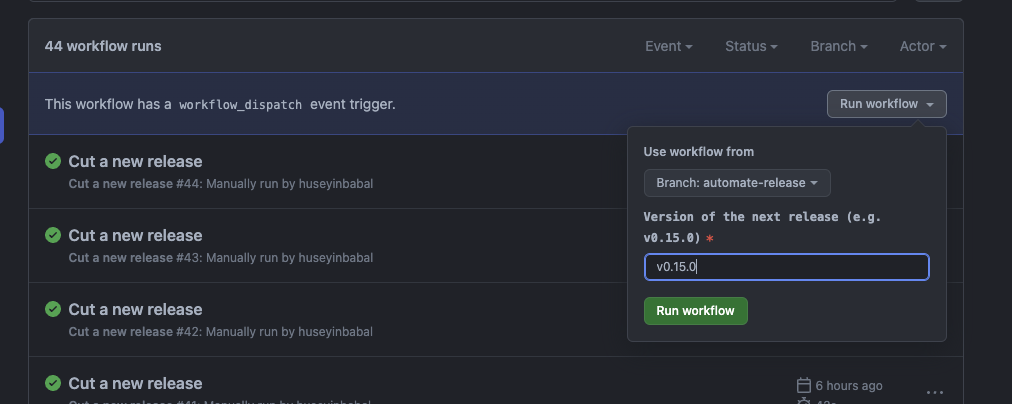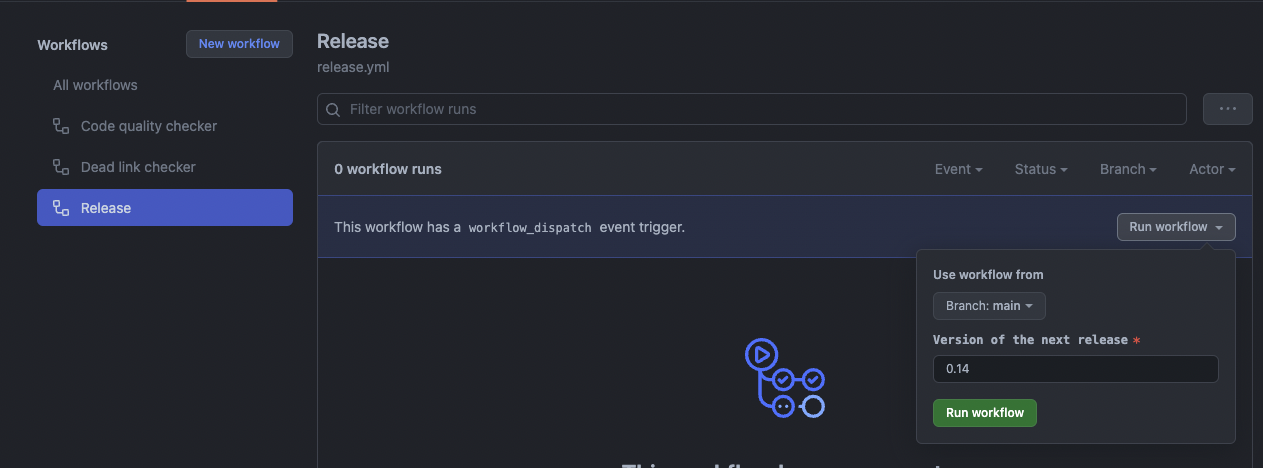Release instruction
This document describes how to prepare and publish a new Botkube release.
Prerequisites
- Proper permission on main
botkubeorbotkube-docsrepositories to trigger GitHub Actions.
The botkube repository
Draft GitHub releases need to be manually checked and marked as pre-releases or published directly in the GitHub UI.
New minor or major release
Navigate to Cut a new release workflow.
Click on Run workflow drop-down, fill Version field. (e.g.
v0.14.0), and click Run Workflow.
It will generate all the needed artifacts and tag it with a release candidate tag, e.g.
v0.14.0-rc.1.3.1. After final release candidate tests have been successful, continue to step 4.
3.2. If bug is detected in the release candidate, create a pull-request with a bug fix against the release branch. Once the pull-request is merged, and the Prepare next release candidate workflow will be automatically triggered, and a new release candidate will be published, e.g.
v0.14.0-rc.2.Navigate to Finalize release workflow and click on Run workflow drop-down and fill Version field to finalize specific release. (e.g.
v0.14.0)
If you need to do the patch release after you executed the Finalize release workflow, go to New patch release.
New patch release
Let say that you have published v0.15.0 release and detected a problem in this version. As an action item, you may want to create set of PRs
against a given release branch which is this case is release-0.15. After merging PRs to that release branch the Prepare next release candidate workflow won't be executed until you will not cut a new patch version v0.15.1.
Navigate to Cut a new release workflow.
Click on Run workflow drop-down and provide a patch release version like
v0.15.1.By doing this, workflow will use
release-0.15as base release branch which was already created in minor and major releases, and will introduce new release candidates on top of that likev0.15.1-rc.1.Rest flow is the same as describe in 3rd point in New minor or major release section.
What this automation does under the hood?
Let say that, our current production version is v0.14.0 and we want to do another minor release which is v0.15.0. Once you apply
the release steps described above, it will perform following actions;
- Creates a release branch like
release-0.15and pushes to remote - Processes Helm Chart to update helm docs, tags it as
v0.15.0-rc.1and pushes to remote - Generates Docker images for Botkube core
- Builds Botkube plugins (sources and executors)
- Generates Botkube plugin index YAML file
- Generates changelog
- Creates draft release candidate with changelog body. Additionally, adds Botkube plugins binaries and index YAML as assets.
- Publishes Helm chart
- After release candidate verification and triggering Finalize Release workflow, it repeats steps 2,3,4,5 with
v0.15.0
The botkube-docs repository
Release Steps
Go to Botkube Docs Actions page, and click Release workflow
Click Run workflow drop-down and fill the Version input for the next release, e.g. 0.14
 danger
dangerDon't use semantic version format, only provide Major and Minor fields of semantic version like
0.14
What this automation does under the hood?
- Generates a release branch like
release/0.14 - Copies current documentation
./docsto./versioned_docs, - Updates
./versions.jsonfile, - Creates new sidebar in
./versioned_sidebars, - Creates an automatic PR against
mainbranch
Archiving the older versions
Currently, archiving older versions is manual. To archive an older version, follow these steps:
Remove the version from
versions.jsonRemove all files under
versioned_docs/version-{version}Remove sidebar file under
versioned_sidebars/version-{version}-sidebars.jsonAdd the version to
versions-archived.jsonwith a working link to the archived version.You can find the link from the Cloudflare Pages job run, e.g. https://github.com/kubeshop/botkube-docs/runs/15868100283.
Release Botkube Cloud
After the releases on botkube and botkube-docs, proceed with the releases related to Botkube Cloud.
- Release Botkube Cloud plugins, matching the Botkube Agent release version.
- Use the latest Botkube Agent version in Botkube Cloud and release it.